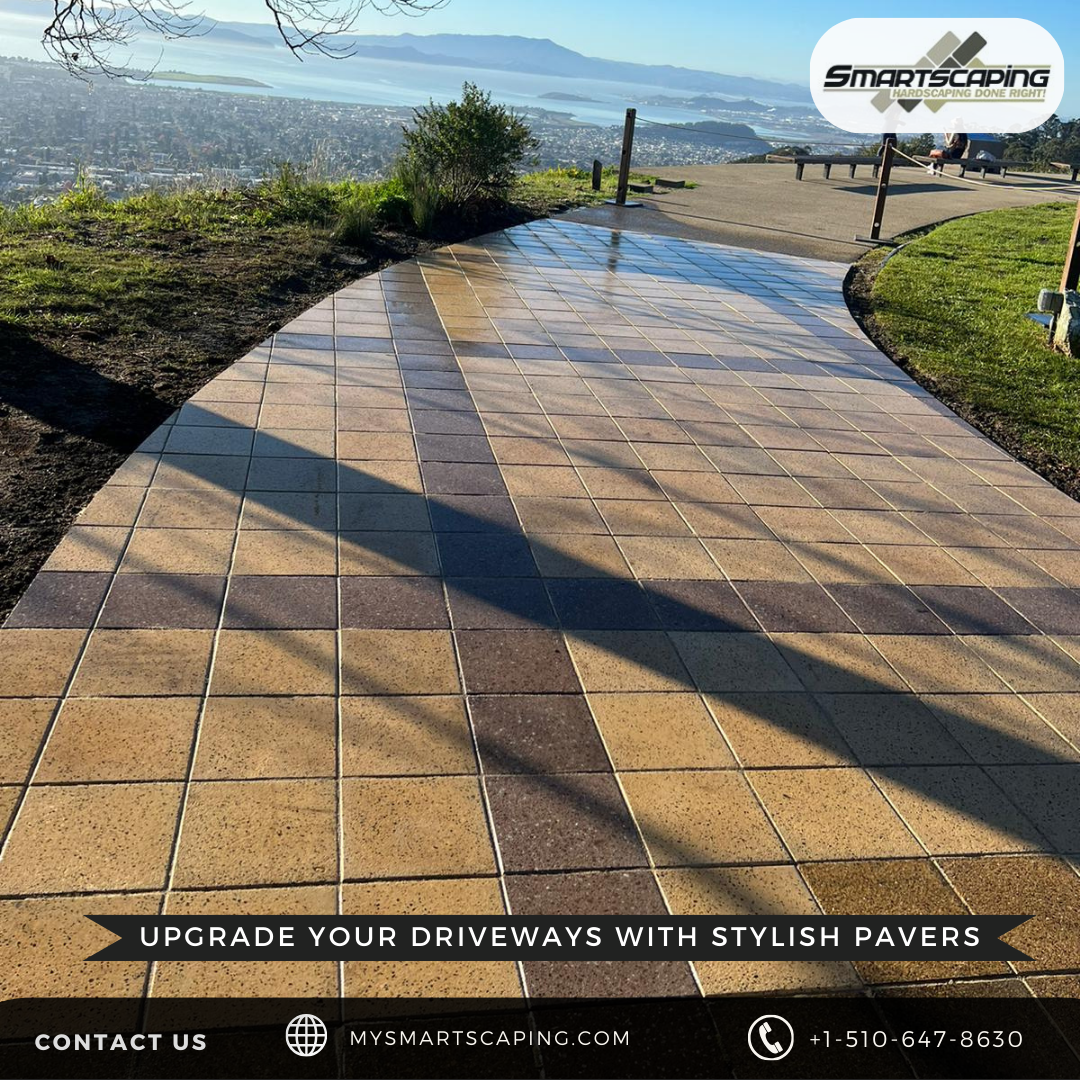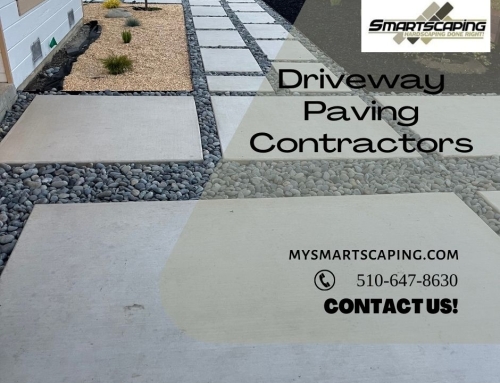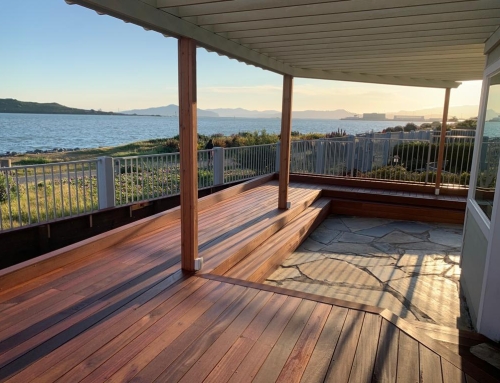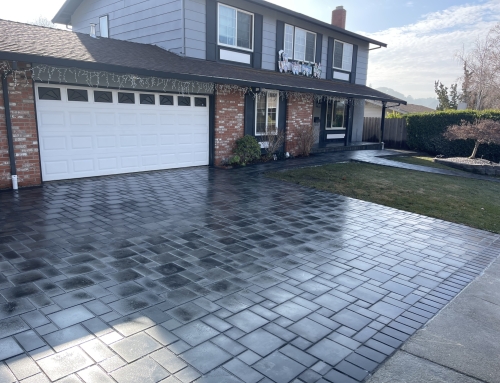When you’re planning a new driveway, upgrading one, or simply dealing with parking issues in front of your home in California, it’s essential to be informed. From what rules apply to driveways in California, to whether you need permission, whether a driveway is private property, and how to stop people from parking in front of your house—you’ll want clarity. And when you’re ready to hire someone to build or revamp your driveway, knowing how your choice of paving contractor, and even a hardscaping contractor fits into the picture makes all the difference. Let’s dive in.
1. What are the rules for driveways in California?
Let’s start with the foundation: the rules governing driveways in California. These rules derive from state law, local municipal codes, county regulations, and include both construction standards (for building or replacing driveways) and parking/vehicle-access rules (for how driveways connect with public right-of-way, how wide they are, etc).
Construction & permit-related rules
If you’re working with driveway contractors, a paving contractor or a hardscaping contractor, you’ll want to make sure the job meets local standards. For example, in the city of Berkeley, California, their “Residential Driveway Guidelines” state that the driveway width, slope and approach must meet certain parameters (e.g., driveway width varies by length and number of cars served, slopes should be under 15 %) for new driveways or major reconstructs. berkeleyca.gov
In the city of Palo Alto, California, you’ll find a permit is required to work in the public right-of-way for a driveway approach, and details such as concrete being required (rather than gravel) within 10 feet of the right of way for certain zones. paloalto.gov
In the city of Los Angeles, California, their permit manual for driveway construction/modification states that any work in the public right-of-way (curb/sidewalk/driveway apron) requires a permit, and that the width, location and slope of the driveway approach are regulated.
What this means: if you are replacing or installing a driveway, you should engage driveway contractors or a paving contractor who are familiar with the local zoning code, right-of-way encroachment permits, and municipal engineering requirements. If you ignore these rules, you risk having to redo work or face enforcement action.
Public right-of-way / driveway approach rules
Because driveways connect to public streets, curb cuts, sidewalk, and the public right-of-way, there are rules to keep the public safe and maintain infrastructure. For instance, the Berkeley guidelines mention that the driveway approach (the portion in the public right-of-way) must meet spacing, slope, width, sight distance standards. berkeleyca.gov
In other jurisdictions, rules limit the width of the driveway apron to curb line—for example in Los Angeles, the maximum width of a driveway apron in “A” or “R” zones is 18 feet unless a deviation is permitted. permitmanual.engineering.lacity.gov
The takeaway: even the “bolt-on” part of your driveway installation counts. If you are hiring a hardscaping contractor or paving contractor, make sure the scope includes the approach and compliance with your local city/county’s right-of-way and driveway approach standards.
General rule summary
-
You often need a permit before installing or modifying a driveway that affects the public right-of-way.
-
The driveway width, slope, location, materials may be governed by city or county code.
-
The portion in public right-of-way is especially regulated: perturbing curbs, sidewalks, trees, utilities often triggers extra rules.
-
Even if your driveway is “on your property,” how it connects to the street may bring it under regulation.
Therefore when working with a driveway contractor, make sure that they are aware of local permit requirements and coordinate with the city if needed.
2. Do I need permission to do my driveway?
Yes—in many cases you do need permission. This is not only from local building or engineering departments, but also can include permit requirements for the driveway approach or for changes in the curb or sidewalk.
-
If the project involves public right-of-way (curb cut, apron repair, sidewalk, change in grade) you typically must submit a permit application. For example, Palo Alto’s document states: “It is unlawful for any person to perform any work within the right-of-way of any street in the City without first obtaining a permit to do so from the City Engineer.” paloalto.gov
-
If you are simply resurfacing or replacing the driveway entirely on private property (front yard to garage), some jurisdictions may not require an encroachment permit so long as the approach and curb are unchanged—but always check local code.
-
When curb cuts or new apron width, or relocation of trees/utilities are involved, permit review is essential.
-
From a practical standpoint: when you hire a paving contractor or driveway contractors, ask them: “Will your scope include obtaining/handling the required permits and inspections?”
-
Also check HOA rules (if applicable)—some subdivisions have architectural guidelines or require approval for changes to the driveway or front yard.
Bottom line: do not assume you’re free to just start paving; you may need permission from your local municipality, especially if the public right-of-way is affected. Getting the permits upfront avoids surprises, fines or forced demolition.
3. Is a driveway private property in California?
This is a nuanced question, and the answer is: largely yes within your property lines, but with caveats when it touches the public right-of-way. Also, ownership of the driveway does not necessarily remove all public-use implications (especially for the apron/slope/curb cut).
-
The portion of the driveway that lies entirely on your private parcel—past the property line—would generally be your private property. You own the land (assuming you have title) and control what happens there (subject to zoning/permits).
-
But the part that is in the public right-of-way (often the apron, curb cut) may be subject to regulation and may not be fully “private” in terms of exclusive control.
-
From a legal parking standpoint, for example: It is “generally legal to park in front of another person’s house provided the vehicle does not block a driveway” (according to the California Department of Motor Vehicles as cited by the Sacramento Bee).
-
Also, under California Vehicle Code § 22507.2, a local authority may authorize, by ordinance, the owner or lessee of property to park a vehicle in front of the owner’s or lessee’s private driveway when the vehicle displays a permit issued under that ordinance. This suggests that, by default, parking in front of a private driveway is regulated and the default may prohibit such parking unless the local authority creates a permit system.
-
Therefore: Although your driveway is your private property from the property line back, it does not always grant you complete control over the adjacent curb area or public right-of-way. And parking/traffic laws still apply.
From a practical perspective, for a homeowner working with a hardscaping contractor or driveway contractors: It’s wise to clarify exactly where your property line is, what portion of the driveway is your exclusive control, and what portion is subject to municipal standards or easements. The contractor should account for location, slope, drainage, and ensure that you are not violating local requirements even though you own the property.
4. Is it illegal to park in front of your own driveway in California?
This question often comes up—especially when homeowners block their own driveways temporarily or for convenience. The answer again: it depends—but generally yes, you may be violating parking laws if you block the public sidewalk, or impede the driveway access.
Here are key points:
-
Under California law (Vehicle Code § 22500), it is illegal to stop, park or leave standing a vehicle in certain locations, including in front of a public or private driveway.
-
According to legal commentary: “Under California law, generally, it is illegal to park in front of a driveway, including your own.”
-
The logic: parking in front of a driveway—your own or someone else’s—can impede access for emergency vehicles, your own vehicles, or create a hazard. Many local ordinances or codes treat driveway entrances as no-parking zones.
-
That said, some local jurisdictions (via ordinance) may allow you to have a permit to park in front of your own driveway (e.g., via § 22507.2). But this requires specific local enabling ordinance.
-
Importantly: if the vehicle is parked so that it blocks the driveway access (yours or a neighbour’s), it is considered a violation and may be subject to ticket or tow. FindLaw
So yes, while you might think “It’s my driveway so I can park in front of it,” under California law you may still be breaking the rules—unless your city allows a permit for parking in front of your own driveway and you have that permit. When you’re working with driveway contractors or replanning your driveway layout (perhaps to incorporate additional space or a wider apron) this is something to clarify: will your driveway design enable you to park without encroaching on the curb/sidewalk or violating your local parking ordinance?
5. How to stop people from parking in front of your house in California
Now that we’ve covered the rules, rights and restrictions, let’s focus on practical steps you can take as a homeowner to prevent others from parking in front of your house or driveway—while staying aligned with law and municipal codes.
Step 1: Know your curb & property line
Before investing time or money, check where your property line ends and where the public right-of-way begins. Some homes have a short apron, sidewalk or grassy parkway before the curb. When discussing with your paving contractor or hardscaping contractor, clarify: Where does the private property end? If the public sidewalk or curb is in front, your control may be limited.
Step 2: Clearly mark the driveway access
One of the simplest deterrents is making the edge of your driveway visible and unmistakable. For example: paint or apply decorative paving to the apron or edge to differentiate it from the curb or street. When your driveway contractors install your new driveway or revamp it, talk to them about including a ramped apron or a distinctive border to indicate to others “this is access, not a parking spot.”
While this doesn’t itself guarantee legal protection, it signals to others and may support your case if you need to call enforcement.
Step 3: Use signage or curb-painting (subject to local rules)
Some cities allow curb-painting near your driveway or have “No Parking – Tow Away” signs that you can request. Check with your local parking enforcement or public works department. Some homeowners also use a fold-out sign reading “Do Not Block Driveway” – but signage alone may not be sufficient if the local ordinance prohibits it being ignored.
If a vehicle is parked such that your driveway is blocked, you may call your local non-emergency police or parking enforcement line, and provide them your address, description of the vehicle, license plate and note that your private driveway access is blocked (which is actionable).
Step 4: Install physical deterrents (where allowed)
Some homeowners install bollards, low curbs, or landscaping features (e.g., raised bed, decorative rock) to deter parking directly in front of the driveway—but these must comply with local city/county and stormwater/curb standards. If you hire a hardscaping contractor, you can ask them about adding a short decorative wall or planter that defines the boundary between the driveway apron and the parking area—but ensure it doesn’t violate any required clearances or impede public utilities.
Be careful: you cannot block public sidewalk, gutter flow, or violate sight-distance rules by erecting physical barriers.
Step 5: Work with your neighbours and municipal code
If you’re in a tight street with limited parking, talk to nearby neighbours about the issue. Make it known that your driveway should not be obstructed—people often park obliviously. If one particular vehicle repeatedly blocks your driveway, keep a record (photo, date/time) and report it. Because under the Vehicle Code blocking a driveway is actionable.
Some jurisdictions allow you to request a “driveway permit” so your house has priority on the curb space. Under California Vehicle Code § 22507.2, a local authority may allow the property owner to park in front of the owner’s private driveway with a permit. SPUR
Step 6: Inform your driveway contractors during design
If you are redesigning your driveway or installing one from scratch—this is the moment to address parking conflicts. Ask your driveway contractors:
-
Can we widen the driveway apron, to give you more clearance so vehicles don’t spill onto the street or block the sidewalk?
-
Can we adjust the slope or approach to avoid vehicles overhanging the street or curb?
-
Can we mark the driveway edge, use decorative paving or edging so it’s clearly readable as “driveway access” rather than parking pad?
By doing so, you reduce the risk of blocking the sidewalk or violating local permit conditions, and you make it visually obvious to other drivers: this space should not be used for street parking.
6. Hiring the Right Expert:
Given all the above, let’s talk about how to engage the right professionals for your project. Whether you’re simply replacing a driveway, upgrading it, adding a wider apron, or combining it with decorative hardscape, you’ll likely need help from:
-
A paving contractor: someone who handles paving surfaces, whether asphalt or concrete, knows compaction, base preparation, drainage, and finishing.
-
Driveway contractors: more specialized firms that focus on driveway design, installation, curb cut, apron, and may coordinate grading and permit-compliance.
-
A hardscaping contractor: if your project includes decorative stonework, retaining walls, planters, integrated lighting or hardscape beyond simple driveway paving.
When selecting these contractors, ask them:
-
Are you licensed, insured, and do you carry workers’ compensation?
-
Do you have experience working in our city (e.g., Berkeley / Oakland / Piedmont area) and handling municipal permit requirements for driveways?
-
Will you handle or assist with permitting for the driveway approach, curb cut, and sidewalk/rights-of-way (if needed)?
-
How do you ensure that the finished driveway meets sight-distance, slope and local code requirements (so you don’t inadvertently block your driveway or violate law)?
-
What materials and construction practices will you use? Because a properly built driveway will reduce ongoing maintenance, avoid cracking, and compliance issues with the public right-of-way.
-
Will you mark the boundary of the driveway, ensure the apron is compliant, and coordinate with drainage and utilities?
By doing this due diligence upfront, you ensure that your driveway project aligns with legal and functional goals.
7. Recap & Action Plan for Homeowners
Let’s pull together the key takeaways and suggest a practical action plan.
Key takeaways:
-
Driveways in California are regulated: both for construction (permits, width, slope) and parking/approach.
-
You likely need permission or a permit from your city/municipality if the driveway connects to public right-of-way (curb, sidewalk, approach).
-
Although your driveway is private property from your parcel’s boundary back, the public-facing portion is regulated and you cannot assume you have exclusive rights to the curb space.
-
Parking in front of your own (or someone else’s) driveway may be illegal under California law if it blocks access—even your own access—unless you have a permit or your local ordinance says otherwise.
-
To stop others from parking in front of your driveway: clearly mark your space, use deterrents, signage (where allowed), physical features (where allowed), and coordinate with neighbours/municipal authorities.
-
When redesigning or upgrading your driveway, engage qualified professionals (paving contractor, driveway contractors, hardscaping contractor) who are familiar with local codes, permitting, and driveway-approach issues.
Action plan:
-
Locate your property line and confirm where the public right-of-way ends and your driveway begins.
-
Check with your city or county engineering or building department for driveway/curb-cut/approach permit requirements.
-
If you have issues with people parking in front of your driveway, document the problem (photos, dates/times). Then contact your local parking enforcement or police department to ask about the towing or citation process.
-
If planning a driveway upgrade:
-
Get at least 2-3 proposals from driveway contractors or paving contractors with experience in your city.
-
Ask each contractor about permitting, approach standards, slope/width/drawings.
-
Discuss with a hardscaping contractor if you want decorative edging, plantings, lighting and want to reinforce the driveway’s identity and discourage misuse of the space.
-
-
After installation, maintain clear signage and the look of the driveway edge so it’s visually clear that the driveway space is not public curb parking.
-
If a vehicle blocks your driveway access, call local enforcement promptly: access to your driveway is protected, and blocking it is actionable.
8. Why Smartscaping recommends quality professionals
At Smartscaping, we constantly emphasise that your outdoor hardscape and driveway are more than just visuals—they’re functional assets, investments in access, compliance and longevity. When you hire a paving contractor, driveway contractors, or a hardscaping contractor, you are not simply paying for concrete or stone; you’re paying for peace of mind:
-
Knowing that the slope, drainage, base compaction, curb-cut, sidewalk tie-in, and municipal standards are handled.
-
Knowing the project won’t result in a violation, forced tear-out, or limits on your parking.
-
Knowing that the finished product supports access (for you), looks integrated with your landscaping, and resists future problems (cracks, pooling water, permit issues).
In a market like California (especially in the Bay Area) where space is tight and parking/curb issues are common, hiring the right team is crucial. Your driveway is the threshold between your home and the public street—make sure it’s properly built, legally compliant, and serves your needs.
9. Final thoughts
In summary: driveways in California live at the intersection of private property and public infrastructure. That means you must approach them with both design and legal awareness. If you’re planning a new driveway or having your current one upgraded, don’t leave the permitting, approach or parking-in-front issues to chance.
• Engage driveway contractors or a paving contractor who know your locality’s code.
• Think about how you can prevent others from parking in front of your driveway—clearly mark it, use deterrents, consider design changes.
• Confirm whether local code allows you to park in front of your own driveway (in many cases it doesn’t unless you have a special permit).
• If someone else is parking in front of your driveway blocking access, act—document, call enforcement.
• Treat the portion of your driveway in the public right-of-way with special respect when you rebuild or upgrade—it’s not just your property, it’s regulated.
With the right planning, the right contractor team (paving contractors, hardscaping contractor) and awareness of your rights and responsibilities, you can have a driveway that is beautiful, compliant, accessible—and doesn’t become a headache because someone keeps parking in front of it.
Smartscaping stands ready to help you evaluate your driveway, connect with top-tier driveway contractors, and ensure your project aligns with California rules and your home’s long-term value. When you’re ready, let’s talk about your driveway overhaul or hardscape upgrade—and we’ll make sure your design supports both function and curb appeal.







